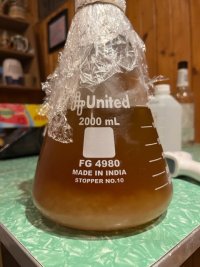iowahomebrew
New Member
Hello Everyone! I'm trying to propagate yeast from one of my favorite saisons. I took the dregs from 6 cans of the saison and pitched it into 1000 ml of starter wort at 1.026, let it spin for 5 days, cold crashed, decanted. I then pitched what was left into a new flask with wort of the same volume and SG and let that spin for 4 days. After cold crashing for 24 hours - this is what I have. I've been brewing for 8 years and I've never seen a yeast starter look like this after cold crashing. Does anyone have an idea of what I have here? Cleanliness and sanitation were of the utmost priority but I know that the nature of propping yeast from a can might have led to an infection.





